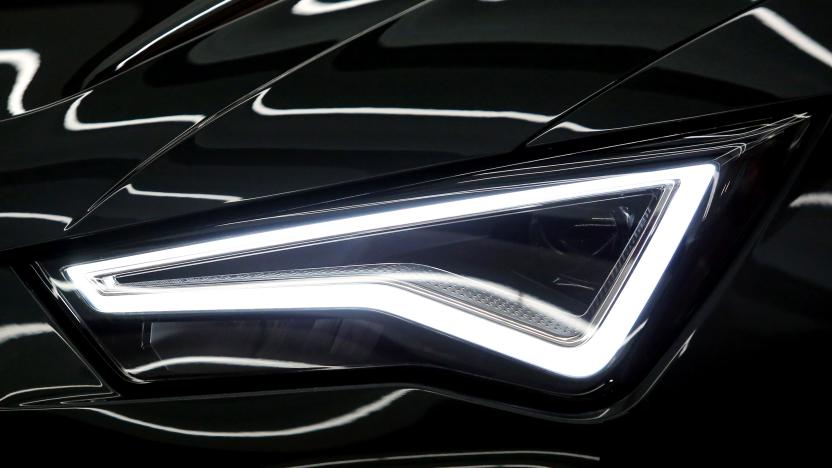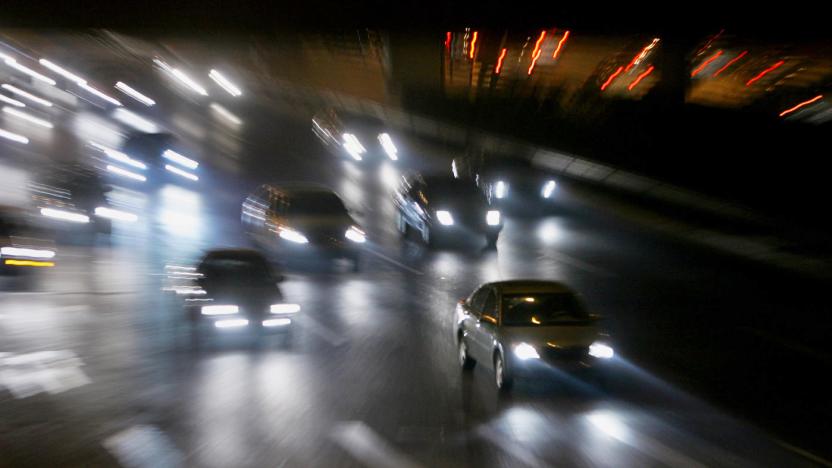headlights
Latest

Adaptive 'high-definition' headlights are just around the corner for American drivers
Until recently, the cutting-edge features found in European and Canadian headlights weren’t allowed on US vehicles due to an NHTSA regulation from the 1960s. But times change, and so too apparently, do Federal Motor Vehicle Safety Standards.

1,000-pixel headlights could offer improved vision at night
Researchers at the Fraunhofer Institute have developed a new headlight technology that automatically and intelligently adapt to the current traffic conditions. The team, led by Dr. Hermann Oppermann, essentially wired four, 256-pixel LED arrays together and connected them to a driver electronics chip. With it drivers will be able to have permanent high-beams that automatically dim when an oncoming car is detected. The head lights will also follow the course of the road (like an old 1940's Tucker) by blinking individual pixels on and off. What's more the system will reportedly be exceedingly efficient since it automatically turns off any unneeded pixels.

Car headlights of the future won't blind other drivers
Carnegie Mellon's work on headlights has made an appearance here before, where it's near-future smart headlights would parse raindrops and 'cancel' them out, projecting light around the rain drops, substantially improving visibility. But that's just one of many tricks that the Carnegie Mellon University Robotics Institute's smart headlights are now capable of. The newest iteration's feedback system continuously looks at what your headlights are doing, processing and thinking about how to shine better. To start, the system detects vehicles headed towards the car and disables the range of light that's directed at the oncoming driver, even on high-beam settings.

BMW wants to put super-efficient OLED tail lights on your next car
The tail lights on most existing cars leave a lot to be desired: they're big, power-hungry and need reflectors to be visible from all angles. BMW is clearly frustrated with those clunky designs, as it just shared a load of details about its upcoming, OLED-based Organic Light technology. The extra-thin, uniformly lit strips promise tail lights (and some interior lights) that are both easy to see without reflectors and use just a fraction of the power of existing systems. They should also lead to more exotic-looking cars -- BMW can already cut the OLEDs into any 2D shape it likes, and it's planning both flexible and 3D lights in the future.

Carnegie Mellon smart headlight prototype blacks out raindrops for clearer view of the road
Researchers from Carnegie Mellon have developed a prototype smart headlight which blots out individual drops of rain or snow -- improving vision by up to 90 percent. Made with an off-the-shelf Viewsonic DLP projector, a quad-core Intel Core-i7 PC and a GigE Point Grey Flea3 camera, the Rube Goldberg-esque process starts by first imaging raindrops arriving at the top of its view. After this, the signal goes to a processing unit, which uses a predictive theory developed by the team to guess the drops' path to the road. Finally, the projector -- found in the same place as the camera -- uses a beamsplitter like modern digital 3D rigs. Used in tandem with calculations, it transmits a beam with light voids matching the predicted path. The result? It all stops light from hitting the falling particles, with the cumulative process resulting in the illusion of a nearly precipitation-free road view -- at least in the lab. So far, the whole process takes about a hundredth of a second (13 ms) but scientists said that in an actual car and with many more drops, the speed would have to be about ten times quicker. That would allow 90 percent of the light located 13 feet in front of the headlights to pass through, but even at just triple the speed, it would give drivers a 70 percent better view. To see if this tech might have a snowflake's chance of making it out of the lab, go past the break for all the videos.

BMW developing laser headlights, officially over LEDs
We know, our whip doesn't have LED headlights either, but that's not stopping BMW from pressing on with its laser powered successor. Purportedly ready "within a few years," the updated beams boast an intensity a thousand times greater than their forebearers, all while consuming less than half the power -- helping EV drivers eke out a little more range. With each laser diode one hundred times smaller than its LED counterpart, Bavaria reckons the tech will help it design and package future light fixtures that are more bodacious than those from its competition in Ingolstadt. There's no firm date for availability, but the company says the new lighting tech will debut on the production version of its i8 concept. Sounds great, so where do we sign up for our frickin' laser bimmer?

LED headlights can add up to six miles of electric vehicle range
We've been charting the progression of in-home lighting, CFLs replacing incandescents but themselves slowly walking the path obsolescence as LED bulbs get cheaper and more common. It's much the same on the vehicle lighting front, with LEDs taking over more and more automotive lighting, and now OSRAM Sylvania is giving us another reason to make that happen sooner. LED bulbs can provide the same amount of light as traditional incandescent car bulbs with less than 25 percent the energy draw. On a gas-powered auto that's not such a big deal, where LEDs are being used primarily because of benefits like cooler temps, longer life, and greater stylistic freedom, but on an EV that reduction in current draw can offer as much as a six mile boost in range on a single charge. That may not sound like much, but if you ever run out of juice five miles from home you might just change your mind.

BeamAtic Premium headlights let you keep your high beams on all night long
It looks like the highways of Japan could soon get a bit brighter -- at least if these new BeamAtic Premium head lights from Ichikoh Industries ever catch on. Developed by France's Valeo SA, the headlights make use of an on-board camera and some image processing software that tracks oncoming vehicles, and some movable dousers attached to the headlights that are able to deflect the light so it doesn't bother other drivers; the idea there being that you could simply leave your high beams on all the time without worrying about blinding anyone. No word on any plans for a release over here, but you'll apparently be able to get them in Japan next month, and the company is also reportedly looking to talk some Japanese automakers into offering them as a factory-installed option.






